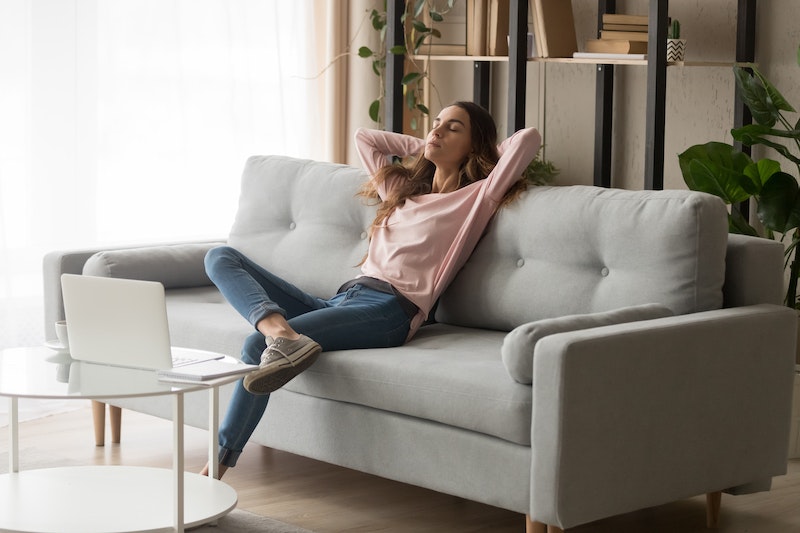Working from home certainly has its benefits — no commute and coffee in your PJs while you read your emails — but it also might mean you’re also spending more time indoors than usual. You also might just be sticking closer to home these days out of safety.
Being cooped up inside too long, though, can make you tired and cranky. Plus, you might not be getting your daily dose of vitamin D which may help with everything from fighting off respiratory infections, to keeping depression at bay, to strengthening your bones. So the next time you realize that it’s been hours since you felt a refreshing breeze on your face, make a point to get up and out.
Here are five ways that being stuck indoors could be affecting your body and what you can do about it.
1. Foot troubles
The problem: Your favorite indoor footwear these days might consist of a pair of beat-up slippers or flip-flops. Or, maybe you’re using this time to let your feet roam free by going barefoot. Going barefoot indoors isn’t an automatic no-no for most people, says Bruce Pinker, DPM, a podiatric surgery specialist. In fact, it can even help strengthen the muscles of your feet, ankles and legs, he says. (If have diabetes, though, you shouldn’t go barefoot. That’s because diabetes can cause loss of feeling in your feet, making it hard to know when you might have injured your foot, say by stepping on something sharp.)
But walking or standing on hard surfaces for long periods while barefoot or while wearing unsupportive shoes, can cause problems, says Nelya Lobkova, DPM, a certified surgical podiatrist with Step Up Footcare. That could include fat pad atrophy, “the loss of the natural fatty pad in the ball of the feet,” Lobkova says, or plantar fasciitis, when ligaments and tendons on the bottom of the foot become inflamed. Both can lead to major heel pain.
The fix: If you’re just relaxing or working at home, a simple sandal, slipper, or even — gasp! — flip-flop will do for footwear. You can even go barefoot on occasion, too, Pinker says. Choose shoes with a cushioned, rocker-bottom sole instead of a flat sole, Lobkova says. Rocker-bottom soles ensure your body weight is evenly distributed across your entire foot and “makes a smooth transition of weight from the heel to the ball of the foot,” she says.
You can also keep the muscles of your feet in good shape by giving them a stretch every now and again. Don’t sit for too long, Pinker says, and to help prevent plantar fasciitis, do easy stretching exercises like using your toes to drag a towel across the floor toward you.
2. Out of whack sleep cycle
The problem: Blackout curtains were invented for a reason. Your body has an internal clock that tells you when it’s time to wake up and when it’s time to go to sleep (known as the circadian rhythm) and it’s all based around light. When it starts getting dark outside, your body releases more melatonin — aka sleepy time hormones. Sunlight, meanwhile, encourages your brain to suppress melatonin. Spending too much time indoors can mean less exposure to daylight and can create a confused body clock.
The fix: Make early morning sun exposure a part of your daily routine, says Beth Ann Malow, MD, a professor of neurology at Vanderbilt University, who is also board certified in sleep medicine. “Not long after you wake up, get out into the sunlight for a few minutes or at least open your bedroom blinds,” she says.
At the opposite end of the spectrum (pun intended), when it’s close to bedtime, make sure the lights at home are dim. Try to turn off electronic devices — TVs, smartphones, computers — at least 30 minutes before bedtime. The blue light from these devices can trick your brain into thinking it’s full-on daytime.
3. Low energy
The problem: When you don’t get enough vitamin D, fatigue can set in. And for many reasons, being stuck indoors all day can “sap your energy and take away your incentive,” says Meaghan Rice, PsyD, a licensed professional counselor. You also might not be getting as much exercise as you did before. Maybe you’re no longer working near your gym or you’re not getting in your 15-minute walk to the train station.
The fix: For a double dose of energizing benefits, combine exercise and being outdoors. A series of studies found that the great outdoors has the ability to improve our vitality and energy. If you can’t get outdoors, though, try to get some indoor exercise to boost your energy levels. Carve out 15 to 30 minutes around lunchtime or before you start working for the day to get outside if you can. Make outdoor time a part of your daily schedule — set aside 15 to 30 minutes before the start of your workday, around lunchtime, or after dinner. A simple walk can do wonders for your mood and energy levels.
4. Sour mood
The problem: It’s not your imagination — when you spend too much time indoors, you really might start to feel down or anxious. There could be a whole host of reasons for that. One is that sunlight boosts your level of serotonin, a hormone that regulates behavior, memory, and mood. In fact, people who have seasonal affective disorder, often have low levels of serotonin.
And you know that old saying, “a change of scenery will do you good?” It turns out that’s not just hyperbole. A study in Nature Neuroscience found that changes in our physical environments can make us happier.
The fix: If you’re working at home, Rice recommends setting up your workstation near a window to get more sun exposure throughout the day. “As much as possible, bring the outdoors in,” she says. “Set up some fresh flowers or plants to brighten up your spaces. Fill your home with outdoor scents like trees, herbs, and flowers.” If you don’t have time to go outside right that minute, crack open a window for a fresh breeze, she adds.
Build in time for socializing, too. Instead of spending 20 minutes doom-scrolling on Twitter, meet up with a friend or family member for a walk. Having strong social connections can help boost your mental health and keep your stress levels in check.
5. Appetite changes
The problem: Guess what — your circadian rhythm doesn’t just regulate your sleep, it plays a role in regulating your hunger, too, a study in Cell Metabolism found. All that indoor time could be making you hungrier at unusual times, like later at night.
The fix: Get yourself on a schedule, both for sleeping and eating. Try to wake up at the same time every day and go to sleep at the same time every night. Also try and eat your meals around the same time every day, which can help with your hunger cues, Rice says. “Be mindful about creating time and space to eat,” she says. Instead of nibbling on a snack every hour to keep hunger at bay, allow your hunger to build a bit and enjoy satisfying it over a lunch break.
You can even take your lunch on the road by eating in your yard or at a local park.





